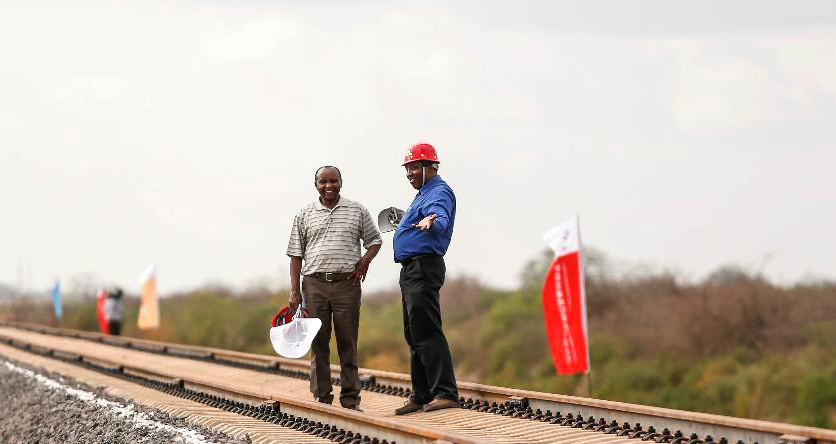‘One Belt, One Road’ signals renewed effort to go global

Two Kenyan engineers conduct a quality test on the construction site of the Mombasa-Nairobi Railway, a project under China’s “One Belt, One Road” initiatives.
The implementation of the “One Belt, One Road” is expected to begin this year. A document recently released by China offers clear guidance for such an enormous project.
The National Development and Reform Commission, the Ministry of Foreign Affairs and the Ministry of Commerce co-sponsored the publication of a seminal document titled Vision and Realization of “One Belt, One Road,” which elaborated on the general background, participatory principles, policy framework, collaborative mechanism, significance, implementation and future direction of this key component of China’s foreign policy.
Scholars say the “Go Global” campaign of the 1990s marked China’s first step into the world market, while accession to the WTO signified its wholehearted embrace of the international trade system. “One Belt, One Road” represents China’s renewed aspirations to foster global commerce and trade.
Bolstered by large-scale infrastructure projects, the overall competitiveness of Chinese enterprises is crucial to the country’s international commercial success in the 21st century.
Zhu Feng, executive director of the Collaborative Innovation Center of the South China Sea at Nanjing University, said integral planning is the highlight of the document. It covers 18 provinces all across China. The northwest, northeast, southwest, inland areas, coastal regions, Hong Kong, Macao and Taiwan are all taken into consideration.
Li Chenyang, director of the Center for Burma Studies at Yunnan University said that, although coastal and border provinces are the main focus of “One Belt, One Road,” support from inland provinces and close cooperation between the two groups are indispensible for overall development.
After analyzing relevant parts of the document, he said “Yunnan Province shall take full advantage of its geographical position through facilitating infrastructural connections with neighboring countries, building a new platform for collaboration in the entire Greater Mekong River sub-region, as well as expanding its influence in Southeast and South Asia.”
In addition, academics should start to research on how to strengthen connections and cooperation among Yunnan Province and its neighboring countries right from the beginning, Li said.
Wang Yiwei, a senior research fellow of Chongyang Institute for Financial Studies at Renmin University of China, said that “One Belt, One Road” should carry out the mission of global rebalancing. He said globalization, a process initiated by Europeans and furthered by Americans, has been a source of entrenched economic inequality, an appalling wealth gap and uneven regional development. Going far beyond the Western-dominated globalization, China’s new cause will usher in a lasting peace, shared prosperity and a harmonious world.
With the intent of building a new Eurasian continental bridge, the document specified three international trade belts on land: one linking China to Central Asia, Russia and Baltic countries; another connecting to Central Asia, Western Asia, the Persian Gulf and the Mediterranean Sea, and a third to Southeast Asia, South Asia and the Indian Ocean.
The 21st century Maritime Silk Road involves two different routes: one running from the coastal cities to the South China Sea, the Indian Ocean and Europe, and the other goes to the South China Sea and the South Pacific. At the same time, the China-Pakistan and China-India-Bangladesh-Burma economic corridors are closely related to the overall design. Large cities, ports and industrial parks will serve to connect these terrestrial belts and sea routes.
In brief, the fate of the state-directed “One Belt, One Road” project is determined by markets, business sense and competitive edge of Chinese companies as well as the overall economic strength of the country, Zhu said.
Zhang Junrong is a reporter at the Chinese Social Sciences Today.
